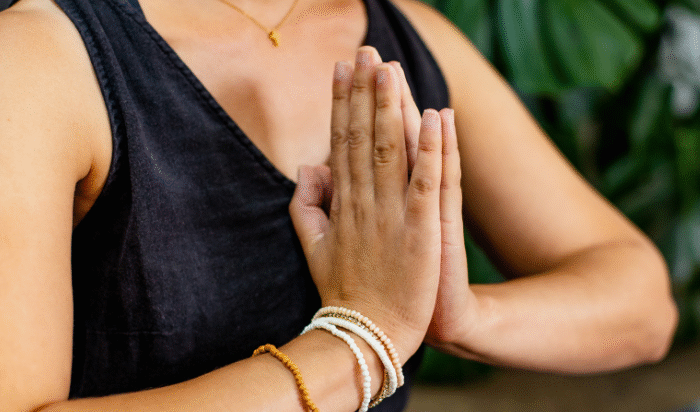The Truth about Yoga: Debunking 3 common myths and misconceptions about yoga
What is the truth about yoga for Christians? Whether you’re brand new to yoga or you have a steady, established practice, you’ve probably heard many common yoga myths and misconceptions that surround the practice of yoga. Maybe you even believe some of them to be true!
As we enter into the new year, I thought it would be a good time to explore and debunk three of the most common myths of yoga and share the real truth about yoga for both newbies and seasoned practitioners.
Yoga myth 1: Yoga is only for flexible people.
As a yoga teacher, people often tell me “I can’t do yoga because I am not flexible” or “I am not good at yoga because I am not flexible”. These statements sadden me because they point to one of the most common myths and misconceptions around the practice of yoga.
The truth is, yoga is NOT only for flexible people! Likewise, yoga is NOT only for skinny people; yoga is NOT only for fit people; and yoga is NOT only for women! In fact, yoga was never intended to be a practice based on one’s physical abilities!
You may be surprised to know that the traditional practices of yoga did not involve the postures that we now call “yoga”. The earliest practices of yoga consisted solely of breath-work and deep meditation performed in a steady seated posture. Over time, other physical postures were incorporated as the body became accepted as a vehicle through which a student could engage in spiritual pursuits. In the article, The Ancient & Modern Roots of Yoga, yoga scholar Mark Singleton explains:
“Postures such as those we know today often figured among the auxiliary practices of yoga systems (particularly in hatha yoga), but they were not the dominant component. They were subordinate to other practices like Pranayama, (expansion of the vital energy by means of breath), dharana (focus, or placement of the mental faculty), and nada (sound), and did not have health and fitness as their chief aim. Not, that is, until the sudden explosion of interest in postural yoga in the 1920s and 1930s, first in India and later in the West.”
The yoga widely known today in the West which emphasizes yoga postures and physical practices is commonly referred to as modern postural yoga.
Yoga myth 2: Yoga is just a type of exercise or a form of physical fitness.
The rising popularity of modern postural yoga in the west has led to the misconception that yoga is ONLY a physical practice or a new type of workout. But yoga is about SO much more than just the physical practices and postures. In her article Myths about Yoga, Busted, Susanna Barkataki writes:
“Yoga is a way of life based on consciously choosing our actions, attitudes and habits. It’s about living in congruence with the ethics, philosophy, and moral values of peace — inner peace, and outer peace.”
The truth about yoga is that it is not merely a form of exercise but is meant to be a spiritual discipline and a way of life. If we approach yoga as just another form of physical fitness, we are not honoring the roots of yoga. In fact, when we approach yoga as only exercise and movement, we are engaging in a form of cultural appropriation of the practice! Asanas, the physical postures of yoga, were incorporated specifically to help students in the spiritual pursuit of experiencing the presence of God.
Separating the physical and spiritual aspects of a yoga practice could be likened to separating the physical and spiritual aspects of kneeling down to pray. While you may be strengthening and stretching the muscles of the lower body while getting up and down from the kneeling position, without the spiritual aspect of the practice, you would miss out on the sweet and powerful benefit of actually entering into a conversation with God through prayer.
Yoga myth 3: Yoga is a religion.
As a yoga teacher who is also a follower of Christ, I am often asked the questions by other Christians: Is yoga a religion? Or Is yoga a religious practice? These common misconceptions around the practice of yoga are rooted in ignorance and misunderstanding about the ever-evolving practice of yoga.
Yoga is not a belief system. Yoga is a spiritual path which can be practiced within various different belief systems. While it is true that yoga was birthed through Hindu and Buddhist cultures, the practice has been used for centuries in various world-views and beliefs systems to help people to build strong, flexible bodies, to create clear, focused minds, and to nourish and deepen one’s spiritual life. David Frawley makes this point in his interview found in the Yoga Journal article, Is Yoga a Religion?
“Yoga’s not a belief system. And many of the other traditions coming out of India—Hindu and otherwise—are not belief systems like Christianity, which has one singular perspective that followers have to adopt.”
The word yoga, from the Sanskrit root yuj, literally means “to yoke” or “to unite”. This union can take on different meanings to different people. For example, yoga can point to the union between the body and the mind or the union of one’s individual spirit with the divine Spirit of God.
Additionally, the term yoga not only refers to union as a state of being, but it also can be translated as a spiritual path or practice which originated in Southeast Asia thousands of years ago. Simply put, practicing the “path of yoga” is meant to lead to the “state of yoga”.
Is it Ok for Christians to do yoga? As a follower of Christ, I find the spiritual path of yoga to be a spiritual practice that fulfills a deep longing within the modern western Church. Yoga invites the whole person: body, mind, soul, and spirit into a process of awakening to the presence of God. Much like chanting, fasting, prayer, service, and the study of scripture, the path of yoga when practiced as a spiritual discipline can be practiced within different world-views and in varying belief systems.
Practice Christ-Centered Yoga With Me
Interested in learning more about yoga from a Christian perspective and developing your own practice? I’d love to invite you to practice Christ-centered yoga with me inside my online yoga membership, The Yoga Abbey. We offer monthly yoga flows, meditations, and contemplative prayers. Getting Still readers can get one week free with the code 1week. Check out The Yoga Abbey today!
Longing for a more embodied faith?
Practice, connect, and cultivate a deeper relationship with God in The Yoga Abbey– your online sanctuary for Christ-centered yoga, meditation, and prayer.
Join today and get instant access to over 1,000 Christ-centered yoga, meditation, and contemplative prayer practices!






